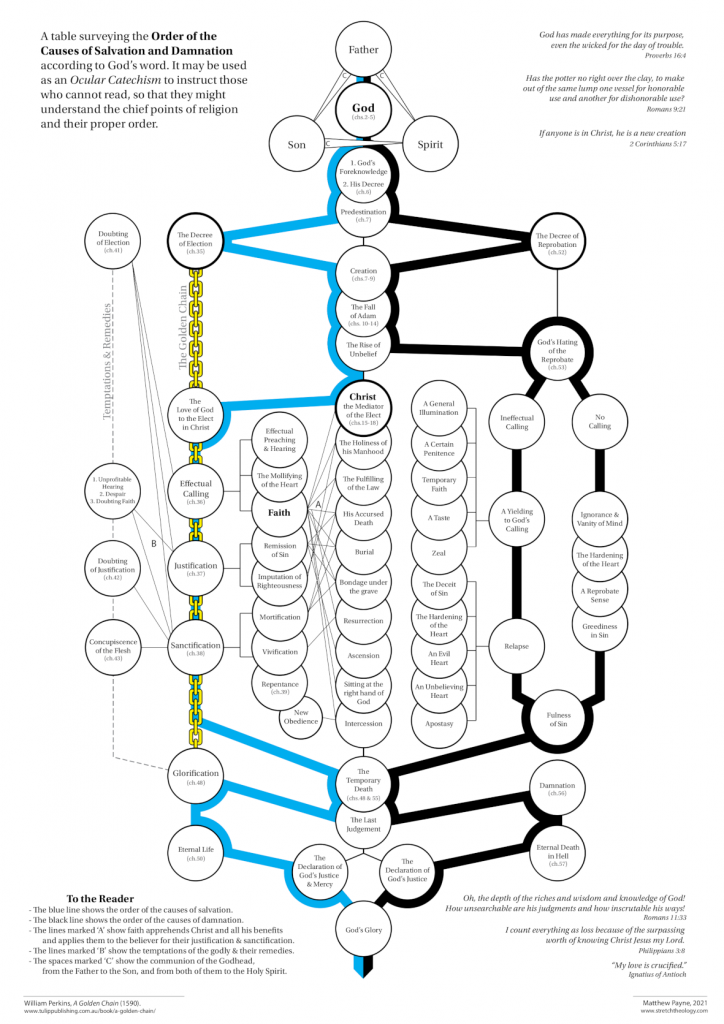
Tulip Publishing has just released an updated language edition of William Perkins’ A Golden Chain (1597, orig. 1590). I coedited this volume with Mark Smith. Without simply rehashing the introduction I wrote for the book (I mean, I want you to buy it!), I thought it worth laying out why I think this book is worth reading today.

William Perkins (1558-1602) is remembered for quite a number of things. He is reputed to be the ‘father of Puritanism’. He wrote the first English-language book on preaching and was among the greatest preachers of his era. He was highly influential in the areas of pastoral counselling, how to have assurance of salvation, the role of conscience in the Christian life, and much more. But he is best known for his teaching on predestination.
Perkins’ Predestination Chart
Perkins’ predestinarian teaching was not unique – it was actually very mainstream in his day. But Perkins was exceptionally good at formulating and teaching theology clearly, and his work appealed to university students and commoners alike. Much of his notoriety in relation to predestination stems from the fact that his most significant book on the subject, A Golden Chain, featured a large fold-out chart which laid out God’s plan of predestination in some detail. I have produced an updated and modernised version to accompany the book (links at the bottom of the page):
The basic idea is that God’s will (or decree) is the ultimate cause of all things. Thus, the diagram portrays the ‘causality’ of salvation, portraying how God’s eternal plan comes into effect in time and space, particularly in the lives of individual people, who are variously destined for salvation or damnation.
Perkins’ taught what is known as double-predestination: that God’s will decided the eternal destination of the elect and reprobate alike. The contrast is single-predestination, where God actively chose some for salvation and passively passed by the rest. Perkins taught that both sides of predestination (election and reprobation) were entirely God’s sovereign decision. That is, they were not caused or influenced by God passively foreseeing our choices, or anything else. On the diagram you can see the path of elect in blue, and of the reprobate in black.
The diagram makes Perkins’ theological framework easy to understand, but it can also leave some uncomfortable impressions. Isn’t this fatalism? Won’t it lead some to conclude that they are destined for hell and despair? Will it lead to spiritual apathy? Doesn’t backsliding show that you are reprobate? Does double-predestination mean that God condemns people just because he wants to, and not because they are sinners who justly deserve it? Does it mean that we should only present the gospel to people who already show evidence of being elect? Perkins’ answers to all of these concerns is a clear “no,” but you’ll need to read the book to consider his explanation of these important issues.
The Interconnectedness of God’s Plan
Perkins’ chain is simply the framework taught in Romans 8:29-30, namely Election, Calling, Justification, Sanctification, and Glorification. God’s eternal plan works out in the experience of his elect as they are:
- Called to faith by the Holy Spirit through the preaching of the gospel,
- Justified by Christ through faith,
- Sanctified to become more and more like Jesus over time, and
- Glorified with Christ when they arrive in his kingdom.
Perkins uses this framwork to join together a range of other aspects of theology and the Christian life. For example, how does the work of Christ in all its aspects (incarnation, death, resurrection, etc) apply to us in salvation? What hindrances and temptations can we expect to oppose us our progress along the chain? Perkins pulls together the Bible’s teaching on a range of issues relating to salvation, and show to their theoretical and practical importance.
Whether or not you agree with Perkins’ views on every issue or not, he offers an extremely well thought-out account of God’s plan of salvation. Wrestling with the issues he presents can only help us to understand God and his plans better.
The Practicality of Predestination
But isn’t this all just abstract, ‘scholastic’ theology disconnected from living the Christian life? Absolutely not!
Perkins thought that predestination was one of the most practical doctrines of the Bible. It empowers assurance, motivates obedience, and leads to prayer and an active spiritual life. Perkins seeks to show how predestination is the foundation of all genuine spiritual experience. Not only is the last chapter called “The Application of Predestination”, but there is application throughout the book.
I genuinely believe that this is an important book that can benefit a lot of people. Grab a copy and wrestle with understanding (and living out) God’s eternal plan of salvation!
Appendix: Printable Charts for Download
The original version of A Golden Chain came with a large foldout chart inside it. It is impractical to print these in a small paperback, so we opted to put a simplified version in the book and make printable versions of the full chart available online.
The chart is available in Colour or in Black & White. [click the images below for PDF files]
The chart is designed for A3 sized paper.

Reference:
William Perkins’ A Golden Chain. Edited by Mark Smith and Matthew Payne. Lansvale: Tulip Publishing, 2021.
ISBN: 9780648725053.



